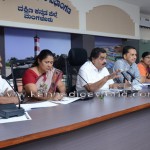New Delhi: After the Jammu and Kashmir elections, which saw the highest voter turn-out in the last 25 years, media has accessed exclusive information on the unprecedented and innovative use of mini-drones and social media by security forces in ensuring that the elections were held peacefully.
NDTV has now learnt that Israeli-built Heron Unmanned Aerial Vehicles of both the Indian Air Force and Indian Army were heavily deployed for surveillance over highly-sensitive areas in the Kashmir Valley like Kupwara, Sopore, Hazratbal and Shopian.
The Herons, along with Indian-built mini-drones, were used in the weeks before voting began in December to monitor movements around polling booths in potential trouble zones. They remained on station right till after voting finished, when electronic voting machines were safely deposited to local counting centres. In fact, several of the vehicles used to transport the Electronic Voting Machines were tracked from the air through real-time video data links from the drones to ground operators, who would have instantly alerted security forces if there was any attack by militants on the vehicles.
The use of the drones (the exact number is classified) was closely coordinated by Joint Control Rooms manned by the Army, Police and para-military forces.
The endurance and range of Herons (they can fly for several hours at high altitudes) meant their posts in the sky were planned well in advance; the use of mini-UAVs was often based on developing situations which local commanders wanted to monitor.
The Mini-UAVs used were built by a firm named Ideaforge in Mumbai set up and run by IIT Mumbai alum. These drones have a range of five kilometres and can fly for just an hour. They were used to provide local commanders at ground control stations real-time footage of known trouble spots.
The use of UAVs was carefully planned ahead of the polls to ensure the most critical areas in the state would always be watched; training missions were held for operators.
As important for security forces was the use of WhatsApp groups, said sources. Joint Control Rooms (JCRs) manned by the police, Army and members of the para-military CRPF were sharing minute-by-minute information with Police Control Rooms (PCRs). Access to these WhatsApp groups was extremely selective to ensure that sensitive information was not leaked. The use of WhatsApp did away with the need of wide-spread radio communications which can be intercepted.
Among those who accessed the live flow of information on WhatsApp were four core groups set up to monitor the elections. These included the Director General of Police, the Army’s Corps Commander and a handful of senior officers of the Central Armed Police Forces. The Core groups ensured that a three-tier security system was in place for each “hotspot”. The police were allotted the role of first responders, the CRPF formed the second tier and the Army manned the outer tier of defence.
Jammu and Kashmir recorded an estimated 65 per cent voter turnout, a fact the Election Commission referred to as historic and unprecedented.


